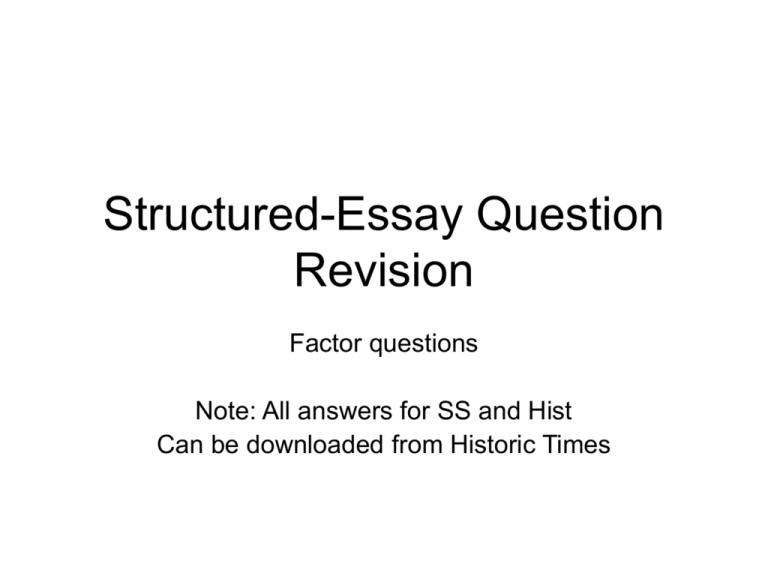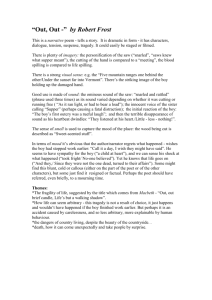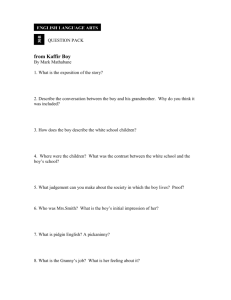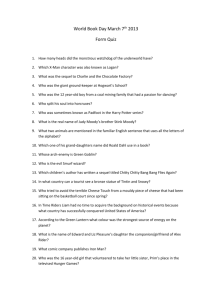Structured-Essay Question Revision - The-Historic
advertisement

Structured-Essay Question Revision Factor questions Note: All answers for SS and Hist Can be downloaded from Historic Times Structure for SEQ Factor • Intro: Identify all three factors + state argument briefly • Para 1: Examine how given factor has contributed to the issue. PEAL • Para 2: Examine how other factor 1 has contributed to the issue. PEAL • Para 3: Examine how other factor 2 has contributed to the issue. PEAL • Conclusion: Weigh the three factors. Explain (with reference to all three factors) why a particular factor is “the most important.” “the most important” (very vague term) You need to provide a criterion to define “most important” Which of the following is the best guy for you? EYA • Scenario: There are three guys who are after your hand in marriage. You have to decide which one you wish to marry, and justify your choice to your parents. • “Weighing” requires you to compare all three guys with each other, based on your criterion. • “the best” – very vague. What is the criterion? • Boy A: Tall, dark and handsome. (a model) • Boy B: Has money flowing out of his ears (a business man) • Boy C: Your # 1 fan. (a teacher) Your choice of the “best” guy will depend on your criterion of selection. • If your criterion is based on “appearances”, then you might pick Boy A: • Boy A is the best guy for me because he has the best appearance of the three guys. Although Boy B is very rich, but he has looks that only a mother can love. Moreover, Boy C, much as he is faithful to me, he is 5 cm shorter than me. So in conclusion, I choose to marry Boy A because I am physically attracted to him, but not to Boy B or C. Your choice of the “best” guy will depend on your criterion of selection. If your criterion is based on “financial security and comfort”, then you might pick Boy B: Boy B is the best guy for me because he has the greatest financial security of the three guys. Although Boy A is good looking, he might lose his looks as he ages, and this means that his modelling career will eventually be in jeopardy, and we may not have sufficient funds for retirement. Moreover, although Boy C is faithful to me, he is only drawing a lowly pay as a teacher, and it doesn’t seem likely that he will be able to rise above that position. So in conclusion, I choose to marry Boy B because he is the son of an extremely established business man, and will be able to provide for my financial security, as well as the well being of our children in the future. Even if it doesn’t work out for us in the long term, I can still sue for alimony, and can thus continue to live a life of luxury. “The most important” • Examples of criterion: - The underlying factor (without which, the other two factor cannot exist) Good governance. SS - The long term factor (which led to other short term factors) Communism - The deciding factor (without which, it would not have led to that particular outcome) Stalin/Hitler’s rise to power. - The most basic necessity (all other factors deal with higher needs) Conflict between states. SS Which of the following is the most important for good governance? -Leadership/Meritocracy/Adaptability In conclusion, good leadership would be the most important factor for good governance, as it is the underlying factor, without which, the principles of meritocracy and adaptability cannot be realised. It is only a good leadership which implements the principle of meritocracy where the “best person gets the job” that they will be able to recruit the best talents to lead Singapore forward and to ensure social stability through a fair system of promotion according to merit. Also, it is only a good leadership that will see the need to constantly adapt to the changing face of the world so as to keep Singapore competitive and attractive to foreign investors, thus ensuring that Singapore remains economically viable and that its citizens enjoy a high standard of living. Which of the following was the most important reason behind the rising tensions in international relations in the 1930s? Explain your answer. -Communism/ Great Depression of 1929 /Territorial ambitions In conclusion, I would argue that the Great Depression was the most important factor as it was the long term factor that made the fear of Communism more real, and made rearmaments an attractive way in which to solve the problem of unemployment. The Great Depression saw the collapse of the American economy, and showed clearly that the system of Capitalism was flawed. This in turn made the Western Capitalist states even more fearful about Communism, as they were afraid that the communists may take advantage of this unstable situation to launch a take-over. It was the Great Depression too, that gave impetus to the policy of rearmaments, which provided Germany with the concrete means to fulfill her territorial ambitions. To what extent was Stalin’s rise to power due to the weaknesses of his rivals? EYA Although Stalin’s rise to power could not have happened without the failings of his rivals, it is to a large extent due to his own strengths, in particular, his ability to capitalize on the weaknesses of others, which was ultimately the deciding factor. Even though Trotsky was unpopular with party members because of his pride, Stalin did not choose to leave it as that, but rather actively sought to alienate Trotsky from the party by portraying him in a bad light, and by gaining influential supporters within the party for himself. While the rivalry between his rivals weakened each of their positions, Stalin actually skillfully made use of Zinoviev and Kamenev by first allying with them to eliminate Trotsky, and after Trotsky had been eliminated, Stalin found new allies to purge Zinoviev and Kamenev as well. Thus, Stalin was truly a remarkable politician and it is more to his credit, rather than the weaknesses of his rivals, that he rose to become the leader of the Communist Party. Which one of the following factors is the most important reason for the outbreak of tensions between countries? -Conflict over scarce resources/over territories/over ideologies In conclusion, although all three factors have clearly contributed to the outbreak of tensions between countries, the most fundamental and therefore important factor would be conflict over scarce resources. Conflict over territories are often also conflict over resources, rather than over territory per se. China’s conflict with Japan over the Senkaku Islands is less for the land and more for the underwater oil deposits surrounding the Islands. Similarly, USA’s crusade against Iraq was as much an ideological conflict between secular liberalism and religious fundamentalism as it was to secure the oil fields in Iraq. Ultimately the conflict over scarce resources are the most important as it pertains directly to economic survival, which is a basic necessity, in contrast to the intangible gains of national pride and safeguarding one’s identity. A country that cannot survive economically will be dependent on other countries for aid and this eventually compromises both its national sovereignty and identity. Was Protectionism the most important factor leading to the outbreak of war in Asia-Pacific? In conclusion, I would argue that the rise of militant nationalism, rather than Protectionism, was the most important factor in the outbreak of war in Asia-Pacific as it meant that Japan was pre-disposed towards solving problems, such as Protectionism imposed by America, by violent rather than diplomatic means. It also means that even if the League had taken strong actions against Japan in the form of sanctions (like what America eventually did), it would be perceived as an added affront to Japanese national interest, and therefore further justify its need to take active military actions in order to secure resources and markets in Asia-Pacific so as to withstand the perceived anti-Japanese stance of the West. To what extent has common space ensured racial harmony in Singapore society? EYA. In conclusion, the creation of common space is the most important factor in ensuring racial harmony, as it provides the concrete avenue for sustained interaction and bonding to take place, and helps to make the building of a national identity into a reality. For example, the common practices such as the singing of the national anthem and national service for Singaporean men which aim to build national identity can only be made possible through the creation of a common space. Similarly, although safeguarding minority rights is important in ensuring racial harmony, it is necessary for these representatives not to promote their own group’s parochial interests, but to also be mindful of racial sensitivities, which are in our nation’s interest. This racial sensitivity and desire to co-exist peacefully can only be internalised through sustained social interaction with other races in racially-integrated schools, residential areas and national service which have fostered a real and deep sense of national bonds that will help to preserve racial harmony in Singapore. Without common spaces, the building of national identity will remain an empty rhetoric and safeguarding minority rights can become distorted as different groups pursue their respective interests without concern for national interests.






